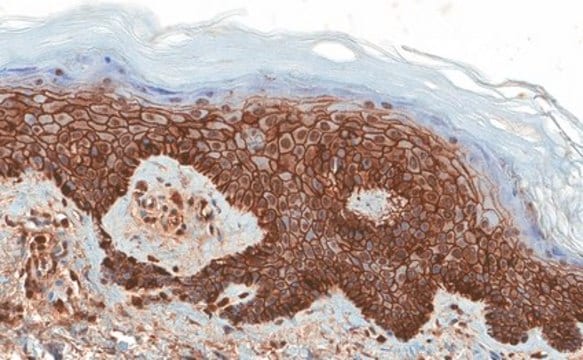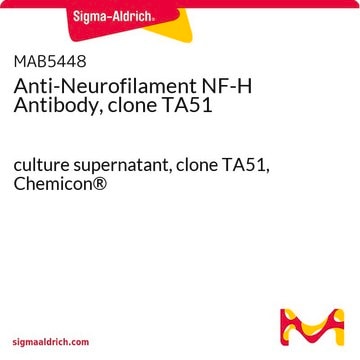MAB5446
Anti-Neurofilament NF-H Antibody, tail domain (Phosphate dependent), clone RMO-24
ascites fluid, clone RMO-24, Chemicon®
About This Item
Empfohlene Produkte
Biologische Quelle
mouse
Qualitätsniveau
Antikörperform
ascites fluid
Antikörper-Produkttyp
primary antibodies
Klon
RMO-24, monoclonal
Speziesreaktivität
human, rat
Hersteller/Markenname
Chemicon®
Methode(n)
ELISA: suitable
immunohistochemistry: suitable
immunoprecipitation (IP): suitable
western blot: suitable
Isotyp
IgG1κ
NCBI-Hinterlegungsnummer
UniProt-Hinterlegungsnummer
Versandbedingung
dry ice
Posttranslationale Modifikation Target
unmodified
Angaben zum Gen
human ... NEFH(4744)
rat ... Nefh(24587)
Verwandte Kategorien
Spezifität
Immunogen
Anwendung
Neurowissenschaft
Neurofilament & Neuronen-Stoffwechsel
Neuronen- & Gliamarker
Immunohistochemistry. The antibody has been used successfully on Bouin′s and alcohol-fixed paraffin-embedded or frozen tissue sections. Formalin-fixed paraffin-embedded tissue sections require pretreatment with trypsin.
Immunoprecipitation
Optimal working dilutions must be determined by end user.
Physikalische Form
Lagerung und Haltbarkeit
Hinweis zur Analyse
Positive Control: Brain
Rechtliche Hinweise
Haftungsausschluss
Not finding the right product?
Try our Produkt-Auswahlhilfe.
Empfehlung
Lagerklassenschlüssel
10 - Combustible liquids
WGK
WGK 1
Flammpunkt (°F)
Not applicable
Flammpunkt (°C)
Not applicable
Analysenzertifikate (COA)
Suchen Sie nach Analysenzertifikate (COA), indem Sie die Lot-/Chargennummer des Produkts eingeben. Lot- und Chargennummern sind auf dem Produktetikett hinter den Wörtern ‘Lot’ oder ‘Batch’ (Lot oder Charge) zu finden.
Besitzen Sie dieses Produkt bereits?
In der Dokumentenbibliothek finden Sie die Dokumentation zu den Produkten, die Sie kürzlich erworben haben.
Unser Team von Wissenschaftlern verfügt über Erfahrung in allen Forschungsbereichen einschließlich Life Science, Materialwissenschaften, chemischer Synthese, Chromatographie, Analytik und vielen mehr..
Setzen Sie sich mit dem technischen Dienst in Verbindung.





